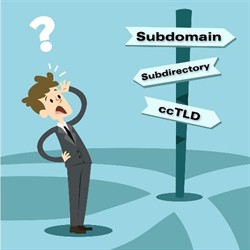Subdomains, Subdirectories or ccTLDs for Global Audiences

Globalization and content are keywords prevalent in SEO discussions in companies across all industries.
Once you decide the international markets to expand into and whether you are targeting by language or country, translating or localizing your website content is a must.
But which domain structure is most appropriate for that content? Subdirectories, subdomains or country code top-level domain (ccTLDs)?
In this blog, I will briefly explain what subdirectories, subdomains and ccTLDs are, and list a few of the pros and cons of each. If you are considering a website localization project, this will provide helpful information to decide which option is best for you.

ccTLD
Moz defines a ccTLD as a domain reserved for a specific country or territory. These two letter ISO country codes show search engines in what country or territory a website is registered.
This type of domain is best when you are targeting based on a country or territory, not a specific language. Some ccTLDs require you to be a citizen or otherwise affiliated with the country to qualify to register that domain.
An example of a ccTLD is, www.example.ae, for the United Arab Emirates.
Countries that use non-Latin characters for their writing systems have top level domains available, called internationalized country code top-level domains.
Below are some of the pros and cons of using ccTLDs from Moz and Seer Interactive.
Note: Image Credit
Pros
- Most reliable way to show search engines and users where a site originates
- Will rank better in target users’ SERPs
- Provides geolocalization signal
- Easy to market
Cons
- Requires separate SEO strategy
- Crawled separately
- Each domain could require technical support and hosting costs
- If country owning the ccTLD is politically unstable, it may be renamed
- You may be subject to censorship measures

Subdirectories
A subdirectory is a directory stored inside another directory, also referred to as a subfolder. Subdirectories are helpful to create separate pages for each of your targeted languages. But, they still exist within your main domain so there is no need for separate hosting.
Subdirectories are appropriate when you are using a language targeted approach and don’t have the technical support or financial resources to manage ccTLDs. This type of domain is also useful as a starting point to see what type of traffic you will receive from your targeted audiences.
According to Search Engine Watch, subdirectories are a good option when you have a generic top-level domain (gTLD) that doesn’t correlate to a specific country, like .com. Subdirectories will add complexity, but it will make it easier to index content on different web versions.
An example of a subdirectory is www.example.com/es for Spanish.
Below are some of the pros and cons of using subdirectories from Moz and Seer Interactive.
Note: Image Credit
Pros
- Only one domain for technical support
- Consolidates domain authority
- Less expensive to manage
Cons
- Can’t have specific IP address for subdirectories
- Has weakest geolocalization signal
- Adds additional complexity with country directories for each version
- Users prefer to browse locally

Subdomains
Subdomains are separate sites affiliated with your primary URL. This type of domain can be used to organize and manage a set of information targeted towards a specific audience.
Subdomains can either be language or country specific. They can be hosted separately, but exist within a generic top-level domain (gTLD.) This type of domain structure is appropriate if there isn’t a budget for ccTLDs.
SEO Buzz states that domain authority does not benefit subdomains as efficiently as subdirectories. Subdomains require constant, fresh content and backlinks in order to be successful. Hosting costs associated with subdomains can also make it a less attractive option.
An example of a subdirectory is us.example.com, for the United States.
Below are some of the pros and cons of using subdomains from Moz and Seer Interactive.
Note: Image Credit
Pros
- Easier to manage and maintain than ccTLDs
- Possible to have local IP address
- Can have separate, local host
- Easy to track results or conversions on Google analytics
- Multilingual websites for each country
- Can geotarget separately with Google Webmaster Tools
Cons
- Requires separate SEO strategy
- Users prefer to browse locally
- Optimization for localization isn’t as simple as ccTLD
- Adds additional complexity with country subdomains for each version
Summary
Each of these three domain types can be used for website projects. You must consider the type of content you provide along with your website structure to determine if subdomains, subdirectories or ccTLDs are your best option.
International SEO best practices state that ccTLDs are the best way to show search engines and users where a site originates. ccTLDs will also rank higher in users SERPs. However, ccTLDs may not always be the best option when you are localizing your website content.
Technical support, financial resources, and whether you are targeting by language or country are all important factors that must be considered when deciding which domain structure will be your best option now and in the future.
